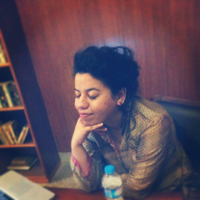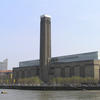More about Black on Maroon
- All
- Info
- Video
- Shop

Contributor
Black on Maroon is a little more special than your average Rothko of hazy, rectangular chromatic fame.
It’s also a wee bit more depressing than the usual tear-jerker Rothko would paint…heck, it makes ME want to curl up in a fetal position and weep to a soundtrack of Fleetwood Mac. Apparently, Rothko had wanted this first painting of an upcoming series to have a lighter feeling to it compared to the others. Err… that plan got seriously foiled!
Perhaps he was trying to change the depression diet for his paintings because this one was destined to adorn the walls of a restaurant in the Park Avenue Seagram Building. The restaurant is one you may have heard of (THE Four Seasons), and it slowly dawned upon Rothko that the elite clientele would be nibbling on their caviar and sipping their champagne before his monumental works. Not an ideal place to place the works of an artist who's used to being a lot more than just background noise! Seeing this, he did a complete 180 and decided his paintings needed a more worthy setting. His statement on the matter was, “I hope to paint something that will ruin the appetite of every son of a bitch in that room.” ‘Nuff said, Mark.
The Tony Award winning play Red, starring Alfred Molina as Mark Rothko and Eddie Redmayne as his assistant, centers around this incident with the Four Seasons.
Although, in retrospect, maybe it wasn’t the best idea to back out of the Four Seasons deal. Here’s why: Rothko ended up bequeathing Black on Maroon, along with a whole bunch of other paintings, to the Tate in 1965. He was thrilled that they would be in the company of Turner paintings, as opposed to some Park Avenue princesses. In theory, this worked out well for everyone – Rothko, the Tate and even the Four Seasons since their customers wouldn’t have to be subject to dark images that offend their palate. But in 2012, while security at the Tate had their backs turned, the painting was scribbled upon in stubborn black ink. It read, “Vladimir Umanets, a potential piece of yellowism.” This nut job was part of some artsy movement back then, and felt like he was Duchamp reincarnate. He thought his vandalizing words would add value to this work of Rothko. Tate did not agree, and 18 months later, with the blood, sweat and tears of many experts, managed to get that ink out of the surface only.
I wouldn’t be surprised if Rothko would’ve preferred having a maniac scribble on his work!
Featured Content
Here is what Wikipedia says about Black on Maroon
Black on Maroon is a mixed media painting by Mark Rothko, created in 1958. It is housed at the Tate Modern, in London.
Check out the full Wikipedia article about Black on Maroon




















